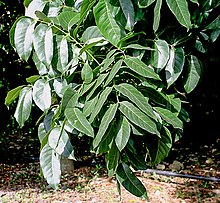Swietenia macrophylla
| Swietenia macrophylla | |
|---|---|

| |
| Leaves in Kolkata, West Bengal, India. | |
| Scientific classification | |
| Kingdom: | |
| (unranked): | |
| (unranked): | |
| (unranked): | |
| Order: | |
| Family: | |
| Genus: | |
| Species: | S. macrophylla
|
| Binomial name | |
| Swietenia macrophylla | |
Swietenia macrophylla, commonly known as big leaf mahogany, is a species of plant in the Meliaceae family. It is one of two species that yields genuine mahogany timber, the other being Swietenia mahagoni.
The species is also known under other common names, including broad-leaved mahogany, Brazilian mahogany, Honduras mahogany, large-leaved mahogany, genuine mahogany, sky fruit, and tropical American mahogany, among others.
Conservation - CITES status
The areas where this species is native (North and South America and the Caribbean) are restricted in use due to the species being listed on the CITES endangered species list as it is threatened by habitat loss. Native mahogany from Swietenia macrophylla has been commercially unavailable since the late 1990s.[1]
Distribution
It is native to Belize, Bolivia, Brazil, Colombia, Costa Rica, Dominica, Ecuador, El Salvador, French Guiana, Guadeloupe, Guatemala, Guyana, Honduras, Martinique, Mexico, Montserrat, Nicaragua, Panama, Peru, Saint Lucia, Saint Vincent and the Grenadines, and Venezuela.
Cultivation
Since the restrictions in logging this tree in its native habitats, it has been introduced into several Asian countries in plantation environments. The mahogany timber grown in these Asian plantations is the major source of international trade in genuine mahogany today. Unlike mahogany sourced from its native locations, plantation mahogany grown in Asia is not restricted in trade. Major Asian countries which grow Swietenia macrophylla are India, Indonesia, Malaysia, Bangladesh, Fiji, Philippines and some others with India and Fiji being the major world suppliers. This tree has a relatively fast growth rate.[2]
As an invasive species
Swietenia macrophylla can become an invasive species when introduced into tropical countries where it is not native. The trees have no natural enemies in their new habitats and grow very rapidly. Seeds sprout in high numbers and tolerate more diverse light conditions than natives, giving rise to dense stands of mahogany trees where no other vegetation can grow, causing severe ecological disruption. It is an invasive species in the Philippines.[3] In Sri Lanka it is an invasive tree in the Udawattakele Forest Reserve in Kandy where it is spreading gradually, although not as rapidly and invasively as the Peru Balsam tree, Myroxylon balsamum.[3][4][5][6][7][8]



Gallery
References
- ^ World Conservation Monitoring Centre 1998. Swietenia macrophylla. 2006 IUCN Red List of Threatened Species. Downloaded on 23 August 2007.
- ^ DANIDA factsheet: Swietenia macrophylla (pdf file)
- ^ a b "N.T. Baguinon, M.O. Quimado and G.J. Francisco, "Country report on forest invasive species in the Philippines"". Retrieved 2010-09-05. Cite error: The named reference "article" was defined multiple times with different content (see the help page).
- ^ Pushpakumara, D.K.N.G. and Hitinayake, H.M.G.S.B. (2001). Invasive Tree Species in Udawattekele Forest Reserve. Sri Lankan Biodiversity Review, Volume 1: 53-63.
- ^ Pallawatta, Nirmalie/Reaser, Jamie K./Gutierrez, Alixis T./eds. 2003. Invasive alien species in south-southeast Asia: national reports and directory of resources. Global Invasive Species Programme.
- ^ N.D.R. Weerawardane and J. Dissanayake, 'Status of forest invasive species in Sri Lanka', in Philip McKenzie, editor, The unwelcome guests : proceedings of the Asia-Pacific Forest Invasive Species Conference, Kunming, Yunnan Province, China, 17–23 August 2003[1] accessdate=2010-09-05
- ^ Pradip Krishen, 'Trees of Delhi a Field Guide',DK publishers, Page 226, 2006
- ^ http://hort.ifas.ufl.edu/database/documents/pdf/tree_fact_sheets/swimaha.pdf
- IUCN Red List vulnerable species
- Swietenia
- Trees of Belize
- Trees of Bolivia
- Trees of Brazil
- Trees of Campeche
- Trees of Chiapas
- Trees of Colombia
- Trees of Costa Rica
- Trees of Dominica
- Trees of Ecuador
- Trees of El Salvador
- Trees of French Guiana
- Trees of Guadeloupe
- Trees of Guatemala
- Trees of Guyana
- Trees of Honduras
- Trees of Martinique
- Trees of Mexico
- Trees of Nicaragua
- Trees of Panama
- Trees of Peru
- Trees of Quintana Roo
- Trees of Tabasco
- Trees of Venezuela
- Trees of Veracruz
- Vulnerable plants
- National symbols of Belize
- Trees of the Philippines




